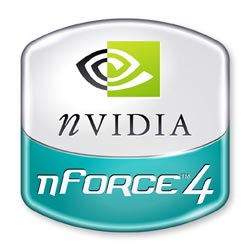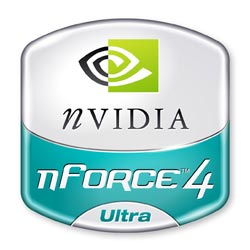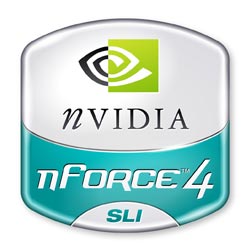nForce4: PCI Express and SLI for Athlon 64
by Wesley Fink on October 19, 2004 12:01 AM EST- Posted in
- CPUs
The nForce4 Family
The nVidia Reference Board was shipped with the nForce4 Ultra chipset. The features of the nForce4 chipset family should be very familiar to nForce3-250 users, since it builds upon the feature set of the nForce3-250 family that was introduced in April. All of the new nForce4 chipsets support 20-lane PCI Express, native Gigabit Ethernet (on-chip), full nVidia RAID features, 10 USB 2.0 ports, nVidia Firewall 2.0, and the new nTune Performance utility. From there, however, the 3 members in the new nForce4 family differ a bit in features depending on the target market for the chipset.
nForce4 - the basic value chipset for 939 and754. This is the chipset that you will likely find in Socket 754 and low-end Socket 939 boards selling for less than $100. The nF4 is targeted at value boards, but it still includes on-chip gigabit Ethernet capabilities, support for 10 USB, full nVidia "any drive" Raid capabilities, support for nVidia Firewall 2.0, and support for the nTune Performance Utility. Four SATA drives are supported at current 1.5GB/s speeds plus four PATA (IDE) devices. The big disadvantage of the vanilla nF4 chipset is that it only supports 800 Hyper Transport. In addition, the HT bus is locked on the basic nF4 to prevent overclocking of the Hyper Transport. This means that the basic nForce4 is not a good choice for the enthusiast, who is better served by the Ultra and SLI chipsets.

nForce4 Ultra - the mainstream nF4 designed for boards that will sell in the $100 to $150 price range. In addition to nF4 features, you will find full support for an unlocked 1000 Hyper Transport, support for 3Gb/s SATA drives, and nVidia's secure networking engine, which is called ActiveArmor.

nForce4 SLI - the high-end version of the nF4 is designed for boards that will sell at $150 or more. The nF4 SLI is the only version to support programmable PCI Express lanes, which allows the use of either a single or dual Video Card. A single GPU is supported by an x16 PCIe slot, which can be reprogrammed to two x8 PCIe slots to support two video cards in SLI mode. All features are, otherwise, the same as nForce4 Ultra.










101 Comments
View All Comments
geogecko - Tuesday, October 19, 2004 - link
#68Hmm...that search result at newegg.com pulls up 12595 results. Far to many for me to look through...
Did you copy the link correctly?
Thanks for the information. If the link won't work, an official part number from newegg (or vendor part number) will work for me.
J.
thebluesgnr - Tuesday, October 19, 2004 - link
I'm a little disapointed that the original article didn't say anything about sound, and that it still doesn't in the "Final words..." page. No, I don't meand SoundStorm.From AT's previous article on CK8-04: "Vanilla flavored CK8-04 is very much the same as nForce3 250Gb, with the addition of 7.1 high definition audio and PCI Express".
So, they dropped the high def audio?
If that's the case both Intel and VIA (if the information on the VT8251 is confirmed) are ahead in this area, which is, for many, much more important than some silly hardware firewall.
In closing, I'm disapointed at AnandTech for:
1) being excessively positive about nForce4 (no mention of lack of high def audio, no mention of any disadvantages of SLI, like higher price of the motherboard and power consumption of two cards, or lack of PCI-E x1 in that MSI mobo);
2) completely ignoring the release of VIA K8T890 and KT880 chipsets.
The KT880 has been out for months, there are motherboards in retail (the K7V88 in particular seems to be doing very well, given the number of user reviews and their ratings on newegg).
Also, you reviewed the [b]nVidia[/b] nForce2 Ultra 400Gb chipset, so "socket A is dead" is not really an answer I'd understand.
haris - Tuesday, October 19, 2004 - link
What's the big deal about SLI? The average increase in performance will probably be around 50-60%. That's nothing to be ashamed about, but at what cost do you get it? Two 6600's still cost almost as much as one high end card, so there is little/no cost savings. What about the power requirements and noise level. That machine has got to be a freaking monster to work/play on.KristopherKubicki - Tuesday, October 19, 2004 - link
Geogecko:http://www.newegg.com/app/SearchProductResult.asp?...
Kristopher
mrdudesir - Tuesday, October 19, 2004 - link
#62First off, each slot is an x16 slot physically but only 8x of actual bandwith. However that still means that each slot has 4GB/s of bandwith, way more than any modern cards used. There will not be any performance hit, simply because the slots have plenty of excess bandwith.
geogecko - Tuesday, October 19, 2004 - link
Can I get an exact part number of the Corsair 3200XL memory you are talking about on the test platform? I've been looking for it, but I've not seeing this 3208v1.1 number anywere...Thanks. By the way, which memory is better, the OCZ or the Corsair?
knitecrow - Tuesday, October 19, 2004 - link
All you guys about doom3 don't need hardware, should read:Http://www.beyond3d.com/forum/viewtopic.php?topic=14459&forum=9
http://www.theinquirer.net/?article=17525
Basically creative said it invented a particular 3d positioning method, Id was forced to license and support EAX HD.
#62, Not unlike a CPU, a GPU is programmable to a certain degree. I am sure you can make it do almost anything.... but a dedicated solution will always be more efficient.
#63 -- "A card based around the VIA Envy 24HT is all anyone needs."
Rubbish.
Envy24 cards do jack for 3d positional audio. If you compare a software based vs hardware based solution, the hardware based stuff (soundstorm, creative noiseblaster stuff) always win out. They are more accurate in their positioning and reproduction.
quanta - Tuesday, October 19, 2004 - link
Actually, id licensed EAX HD for use with Doom 3. Even without EAX HD support, Doom 3 will just send the audio streams to DirectSound 3D engine for mixing purposes, which will take advantage of 3d audio accelerations if any.PrinceGaz - Tuesday, October 19, 2004 - link
Doom 3 doesn't use hardware accelerated sound, so SoundStorm has no benefit. If you are having problems with the sound, you might want to adjust hardware acceleration or something.Sound only takes a tiny amount of CPU power when you've got a processor like a 3800+ so it doesn't really matter whether or not its hardware accelerated. Its even less important when you consider that games are increasingly GPU bound, and that theres plenty of CPU power spare for processing sound. A card based around the VIA Envy 24HT is all anyone needs.
quanta - Tuesday, October 19, 2004 - link
#54/57, the decision to dump dedicated SoundStorm hardware actually made a lot of sense, because NVIDIA already has a powerful VPU that can be used as an APU if the company wanted. In fact, NVIDIA can just license AVEX[1], which currently only works on NVIDIA processors, and if NVIDIA play the cards right, it can just bought the BionicFX company now/soon and keep an edge over the competitions all to itself.As for the SLI, I think it will be too confusing for end users, and the dual slot design will likely be short-lived. Think about it, there are only 20 PCIE lanes on nForce 4, and each video card uses 16, so at least one card only runs a fraction of the speed, crippling performance. It may be technically correct that current apps don't need all 32 lanes, but it will be tech support nightmare for video card manufacturers from users who expected full blown performance. It will be much easier to just build a 16/20/32/etc-lane PCIE video card with two VPUs in it. That way users don't have to worry about the upgrade restrictions and performance issues, and easier for video card makers to sell dual VPU products. Sure, you lose the upgradability, but without tech support problems, card makers don't have to worry about people buying fewer cards because they want to wait for cheaper, more user friendly SLI solutions.
[1] http://www.bionicfx.com/